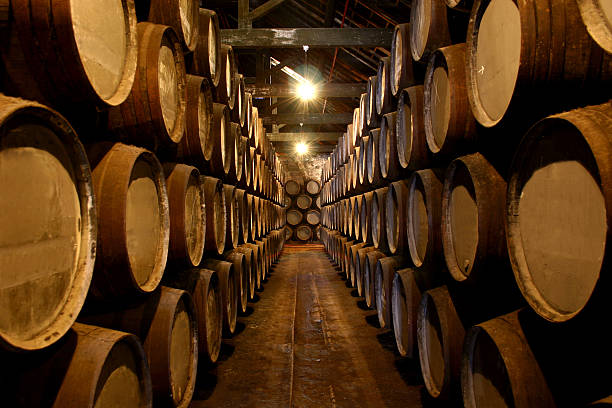Anita Oberholster, a wine chemist in California’s Napa Valley, received hundreds of emails in the weeks following the Glass Fire that ravaged Napa Valley. They wanted to find out if they could harvest grapes without the smoke taint flavor that winemakers so dreaded.
Oberholster of the University of California Davis could only say, “Maybe.”
Grape samples were sent to industry laboratories for testing, and the wait time could be up to six weeks. The growers did not know if it was worth harvesting the crops. In 2020, eight percent of California’s wine grapes were left to rot.
A lifetime’s climate change
Winemakers have experienced the effects of climate change. The warmer temperatures are good for some people in cooler climates who can enjoy riper fruit, but they’re bad for others. Heat waves, fires, and other climate-driven disasters have destroyed harvests across Europe, North America, and Australia.
As 2020 demonstrated, climate change has the potential to affect grapes negatively without destroying them. Wildfires can change the taste of wine. The delicate chemistry and conditions in which grapes are grown determine the quality of the wine. Climate change has many growers and vintners concerned. They fear that it will ruin the flavor of wine or even destroy vintages.
Karen MacNeil is a wine expert who lives in Napa Valley. She’s also the author of The Wine Bible. “That’s what wine is all about — it’s tied to its location.”
MacNeil says that the greatest challenge climate change poses to winemaking is its unpredictable nature. The producers used to be able to predict which grape varieties to plant, how to cultivate them, when to harvest them, and how to ferment the berries to produce a quality, consistent wine. But today, everything is uncertain. Researchers and winemakers are motivated by this growing awareness to find new ways to preserve grape varieties, their unique characteristics, and the changing conditions in today’s world.
We spoke to wine experts in Bordeaux, France, and Napa Valley, California, to learn how climate change has affected their vines and wines. In late 2021, we will travel to Davis and Napa Valley to meet with scientists, winemakers, and growers.
We got an insider’s look at the transformations that are taking place in winemaking to preserve flavors and aromas. And yes, we tasted a lot of wines, from the best Cabernet Sauvignon to those spoiled by heat and smoke.
Growers and winemakers are finding new ways to reduce climate impact. For example, they adapt fermentation to test new grape varieties.
Climate change: The taste of it
Even the most hardy vines can be killed by extreme weather conditions, but the greatest threat to the vines is an invisible one – chemical changes within the berries.
Wine quality is a balance of three aspects: acid, sugar, and secondary compounds. As vines photosynthesize sugar, acid is released as grapes ripen. Over the years, secondary compounds – chemicals that are not essential for the plant’s metabolism – accumulate. Anthocyanins are responsible for the color of red grapes and also protect them from UV rays. Other tannins are responsible for bitterness in wines and a drying, astringent mouthfeel. They also offer vines protection against pests and grazing animals.
The French word “terroir” encompasses a wide range of environmental factors that affect wine flavor. These include soil type, rainfall, and fog.
Megan Bartlett is a plant scientist studying viticulture at UC Davis. She says that when a region’s weather changes, it can affect the balance between sugar, acid, and secondary compounds. This happens by altering the rate of their development over the growing period. As grapes ripen, they break down acids and accumulate sugar. Grapes take on a raisin-like taste when they mature at warmer temperatures.
The alcohol content of wines from warm regions like southern France is increasing. Cecile Ha, spokesperson for the Bordeaux Wine Council, said that this is a bad trend for consumers in the region, particularly because it comes with a decrease in acidity. Acidity gives wines a fruity freshness and helps them last in the cellar for many years.
The delicate chemistry in wine grapes is altered by warming temperatures.
Carolyn Ross, the food scientist from Washington State University who cataloged wine aroma compounds for the annual review of Food Science and Technology, believes that higher alcohol levels can create a burning taste and hide subtle aromas. Boozier wine tends to be spicier. Bartlett says that as the temperature rises, you’ll be pushed to drink more Zinfandel. This is great for Zinfandel. If you plant Cab or Pinot, you are no longer expressing the best of that variety.
If it were just about sugar and acids, then the solution would be simple: harvest grapes sooner, before they become too sweet, and while they retain their tartness. Growers want to see the secondary compounds build up because they are what create the complex aromas that make quality wines. Wine producers may be forced to decide whether they want to harvest early, when tannins and anthocyanins are not fully developed, or later on when the berries have these compounds but are also overly sweet.
The warmer temperatures in the vineyards will bring out more “cooked” flavors, which are ripe. MacNeil describes the progression as follows: “an unripe, an almost-ripe, a ripe, a cherry juice, cherries that were cooked on top of the stove, dried cherries that taste like raisins. MacNeil says that “all raisins taste the same.”
The industry is already experiencing a blurring of wines due to the warmer temperatures and increased weather instabilities, as well as an increase in exchanges between growing techniques. The certification of master sommeliers, a difficult exam that includes guessing the wine’s type, year, and region, has become even more difficult.
MacNeil says that many older masters of wines and master sommeliers will tell you they wouldn’t pass the exam if it were given today, particularly the tasting test.
The taste of fire
While a little smokiness imparted by, say, barrel-aging might enhance a wine’s flavor and aroma, this is a “very characteristic ashtray character at the back of your throat,” as Oberholster describes it. Oberholster says that while a slight smokiness from barrel-aging might improve a wine, the ashtray flavor is “very characteristic” at the back end of your throat and has notes like “Band-Aid,” “medicinal,” etc.
When wood is burnt, volatile phenols are produced. These compounds seep into the grapes, and they accumulate mostly in their skins. The phenols, which are usually bound with sugars, become odorless compounds known as glycosides. This is until fermentation occurs, at which point some of the phenols will break free and impart a distinct, overwhelming flavor. The breakdown continues inside the barrel or bottle and in the mouth. It is best to use fresh smoke on the berries rather than older smoke.
It’s a “retro-nasal” experience, meaning that the aroma is released into your nose once the wine has been sipped. However, 20 to 25 percent of the population may not be able to taste the smokey notes because they lack the enzymes necessary to break the bonds. The problem is mainly with red wines because they are fermented along with the skins.
Anita Oberholster, a wine chemist at UC Davis, studies smoke taint.
As the autumn grape harvest approaches, Napa’s growers are anxious about the recent increase in intense wildfires, which is worsened due to climate change. Napa vineyards have been surrounded by heavy smoke since 2017. Oberholster has been contacted by worried grape growers who have asked for advice. The chemist has also fermented many test batches exposed to different levels of smoke.
On the day that we meet with her, Oberholster takes us to a 24,000-bottle-capacity library of wine at the UC Davis Robert Mondavi Institute. She finds two reds in the stacks and gives us the 2020 vintages. One wine is moderately tainted from grapes exposed for a week to smoke from the Glass Fire. The other is heavily polluted from grapes that were exposed to smoke from a complex of lightning-triggered wildfires that bordered the vineyard in the same year.
Ula’s Reno kitchen table is the next location where we perform a blind tasting. The tainted wine has a campfire smell that Katya feels mostly in her nose, but Ula also feels a burning sensation at the back end of her throat.
Ula writes in her notebook: “Drinking burned wood.” She is referring to the smokier vintage.
Planting more resilient vines
Smoke taint can be obnoxious, even for amateurs. Many winemakers worry about subtler ways climate change can affect the taste and identity of their wines. Producers and researchers in warm regions are preparing by learning how to adapt vineyards, winemaking, and even the vines themselves.
Bordeaux reds, for instance, are full-bodied, with strong fruity scents and an earthiness that is reminiscent of “pencil lead.” The earlier springs have meant that grapes from traditional varieties are ripening in summer rather than the fall. This results in lots of sugars and fewer acids, as well as undesirable aroma changes. Agnes Destrac-Irvine, an agronomist at the French National Institute for Agriculture, Food and Environment, and her colleagues conducted a 10-year study to identify grape varieties that can be adapted better to warmer climates and produce wine with Bordeaux flavor.
They worked with wine producers to select four red and white vine varieties that met the criteria. In a stunning move, the French authorities, who had previously only allowed six traditional white and eight traditional red grape varieties to grow, authorized Bordeaux winemakers to experiment with these new in 2021, as long as it didn’t exceed 10 percent.
Destrac-Irvine explains that these newbies give winemakers a fresh tool to balance the effects of climate changes in Bordeaux blends. The French variety Arinarnoa can increase acidity and tannins, while the Portuguese Touriga Nacional can enhance powerful black fruit aromas. Ha of the Bordeaux Wine Council says that “if you have more colors,” it might give you more options to paint.
The six chosen varieties will only be approved on a trial-and-error basis. In Bordeaux, where vines have been cultivated for 2,000 years, Gregory Gambetta, a plant physiologist with Bordeaux Sciences Agro and Institute of Vine and Wine Science, is frightened by the thought of new types. He says that the traditional varieties are so deeply entwined in the culture and history of the region that it would be better to adapt the system by using other levers.
Gambetta and others are working to study climate-proofing vines using rootstocks that are of a different type. The rootstocks determine a plant’s vigor, water consumption, and overall health. If they are chosen to be tolerant of global warming, then the aboveground varieties, which determine the unique chemistry, flavor, and ripeness of grapes, can still thrive.



